Before computer-aided systems and manufacturing, electronics work was generally done by hand. The electronics systems and technologies of the atomic bomb were no exceptions. Manhattan Project scientists and engineers in Los Alamos, NM designed and developed a number of innovations in the field of electronics. Products of circumstance, these innovations were essential to producing the first plutonium-based implosion device and weapon, “Gadget,” and “Fat Man,” respectively.
Science Behind the Bomb
Differences in the uranium and plutonium atomic bombs can be traced back to the elements’ differences in reactivity and isotopes. Uranium-235 has a “slow” critical insertion time of about one millisecond. Critical insertion time is the amount of time required to form more than enough fissile material to maintain a nuclear chain reaction, known as forming a critical mass.
In the uranium “gun-type” bomb design, a critical mass is generated through firing a sub-critical uranium projectile through a gun barrel at a sub-critical uranium target. The formed uranium mass of both the projectile and the target becomes critical and the nuclear chain reaction is initiated.
Unlike uranium, plutonium-240 has a high rate of spontaneous fission and has a smaller critical insertion time of approximately ten nanoseconds. The gun-type design was not feasible for plutonium-240 because of this increased number of spontaneous neutrons. The spontaneity of these neutrons could have created nuclear pre-detonation fizzle. A pre-detonation fizzle is an explosion caused by the two sub-critical masses of the bomb being brought together too slowly.
Implosion Design Basics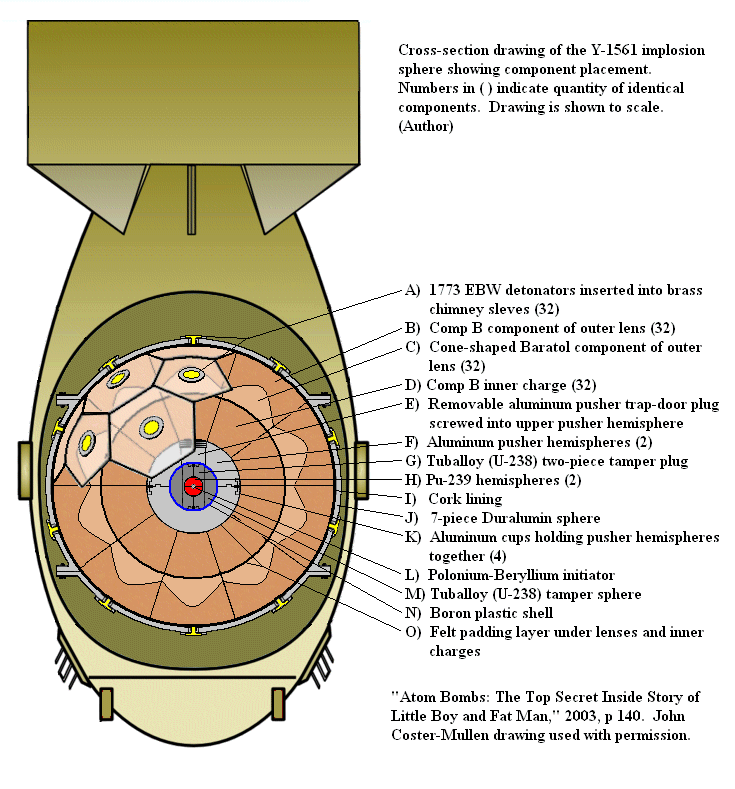
Realizing the uranium gun-type designs were not applicable for a plutonium-based weapon, the Los Alamos scientists were forced to engineer a new design that employed implosion rather than explosion. Implosion is when a burst of force travels inward rather than outward like in an explosion. American physicist Seth Neddermeyer proposed the implosion design that employed the spherical, layered approach ultimately used in the “Gadget” in the Trinity Test and in Fat Man.
In the design, a series of high explosives (lenses) surround a solid sphere of plutonium-239. Nobel-Prize winning physicist Val Fitch explained how the design works in his interview on the Voices of Manhattan Project website. The weapon was engineered so that “you are detonating explosives in such a way to produce a spherical shockwave going inward to compress plutonium to a critical point.” The shockwave brings plutonium to its critical mass point because the compression of the core with the explosives increases the plutonium’s pressure and density.
According to Professor Bruce Cameron Reed, as the core is compressed, the initiator (code name “Urchin”), composed of beryllium and polonium, would emit neutrons to trigger the nuclear reaction. To generate an alpha particle reaction, an alpha particle must collide with the nucleus of a light element. In the case of beryllium and polonium, the beryllium is the light element and polonium is the alpha particle emitter.
Reed shared that the beryllium was apparently a protective layer between the polonium’s alpha particles and core, so that only after “the triggering goes and the device is crushed, the two materials mixed.” Reed admitted, however, that he is only speculating about the initiator’s designs “because apparently, these are still very highly classified.”
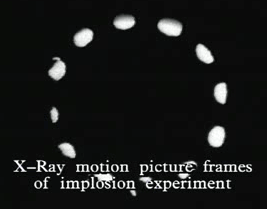
The three main challenges of the implosion design were: generating enough pressure to compress the plutonium, perfecting the timing of the detonators, and achieving a symmetrical implosion. As explained by Reed, “the technique they developed for achieving the compression was to essentially wrap it in segments of explosives in a three-dimensional assembly. Think of sort of pyramid-like chunks of explosives that would fit together like a three-dimensional jigsaw puzzle, which when detonated would blow inward to crush the core.” From the outside, the implosion design resembles a soccer ball with thirty-two lenses fitted together to form a sphere. These lenses are made of a mixture of explosives, and they surrounded a softball-sized core of plutonium.
While figuring out the shape and physical design was an important step, the scientists still needed to ensure that the lenses would detonate with extremely precise timing. In his interview, Reed noted timing was essential because “if the implosion was a little off-centered or asymmetric, the core might shoot out one side.” This asymmetry would result in a much less efficient nuclear explosion.
In order to achieve symmetry, the detonators each had to trigger within a microsecond (one millionth of second) of one another. Reed explained that “in the testing of the implosion bomb, they had something like six different diagnostic tests for the symmetry of the implosion.” Workers used High-speed photography to assess the implosion design on the microsecond timescale. Reed provided more detail saying, “X-ray cameras that could operate at microsecond exposures were used to actually image the implosion.”
Los Alamos Innovations in Electronics
To overcome these major challenges, Los Alamos scientists and engineers developed new innovations in the field of electronics. Three essential innovations for the implosion design’s success were Exploding Bridgewire Detonators, the Spark Gap Switch, and Composition B explosive lenses.
Exploding Bridgewire Detonators
In developing the Fat Man plutonium-implosion bomb, special spark-free detonators called Exploding Bridgewire Detonators (EBWs) were designed at Los Alamos. In his book, The General and the Genius: Groves and Oppenheimer – The Unlikely Partnership that Built the Atomic Bomb, James Kunetka states that the EBWs used electrical discharge from a connected powerful capacitator to vaporize their bridgewire. This vaporization produced a small shock wave that detonated the explosive lenses around the detonators. The EBWs were capable of detonating multiple charges simultaneously.

Each of the thirty-two EBWs was attached to two bridgewires that were housed in separate PETN (pentaerythritol tetranitrate) initial pressing wells (cavities). PETN is a relatively sensitive secondary explosive. According to John Coster-Mullen’s Atom Bombs: The Top Secret Inside Story of Little Boy and Fat Man, there were two bridgewires per detonator in order to account for the high detonator failure rate (p. 60). Each bridgewire was connected to the “Fireset” apparatus, the electrical energy supplier for the detonators.
In order to prevent unintended detonation, EBWs were engineered to require a high-current, fast pulse trigger for detonation. This engineering innovation was developed to prevent setting off the implosion bomb with a simple static spark from static electricity, which is highly prevalent in planes. Another reason EBWs were safer than other types of detonators was that EBWs did not contain shock-sensitive primary explosives like lead azide or mercury fulminate because the bridgewire could explode itself.
The type of EBWs used in the bomb was also called “handlebar” detonators because the two bridgewire fuse “sidearms” and the attached firing cables resembled the shape and angle of bicycle handlebars. The detonator sidearms were made of aluminum, and contained high-voltage copper lead encased in nylon. (Coster-Mullen, p. 64).
Producing these special detonators was a lengthy task. In early 1944, the South Mesa detonator group led by physicist Luis Alvarez began a trial and error process of developing the detonators. The proper combination of bridgewire lengths, diameters and materials for the detonators was not determined until just a few weeks before the Trinity Test in July 1945 (Coster-Mullen, p. 63).
In Atom Bombs, John Coster-Mullen quotes SED member John Tucker, who recalled the detonator group ‘only allowing one or two people to make the assembly of the cable to the detonator sidearm because it was such an art’ (p. 65). Lawrence “Larry” Johnston, director of detonator research and development in Alvarez’s group, holds the patent for the successful EBW design.
Spark Gap Switch
In order to ignite the detonators in a precise manner, a high-voltage electrical system was required. A main feature of the fireset apparatus was the Spark Gap Switch. Physicist Donald Hornig invented the Spark Gap Switch used for the implosion bombs. The switch or “X-Unit,” its code name at the time, was designed to fire all of the thirty-two lens detonators within a microsecond. According to Hornig, his “switch was one of the things many people were most skeptical was going to work.” 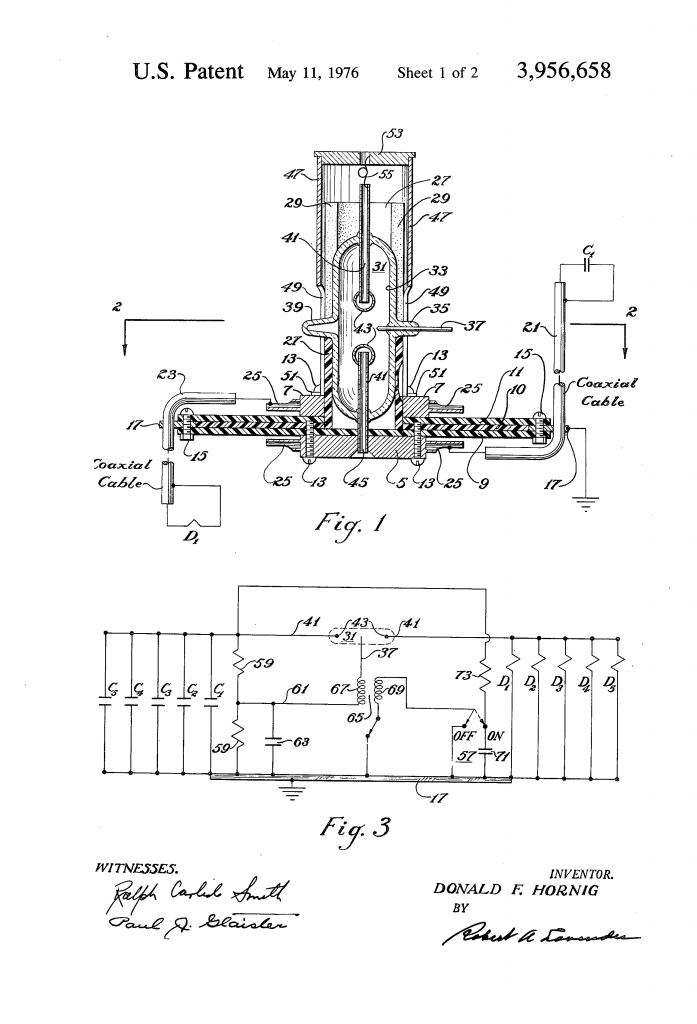
While the typical residential electrical switch could handle about 110 volts of electricity, the Spark Gap Switch was capable of passing the required 5000 volts of energy from the car battery powered generator (“dynamotor”) to the detonators in less than a microsecond. A simple electronic switch could not be used because the implosion bomb required precise, accurate, and extremely fast timing. If a simple switch was used with high voltage (thousands of volts), there would be an increased risk of premature explosion.
According to Bruce Cameron Reed’s The History and Science of the Manhattan Project, Horning’s Spark Gap Switch works in the following way: “High voltage causes a spark to jump between two pieces of metal placed a small distance apart within an explosive” (p. 316). Instead of the explosive from the detonator triggering the implosion explosive lens, the explosive caused a copper ‘slapper’ plate to drive into the lens. This action initiated the implosion using a high-pressure pulse.
In designing the switch, Hornig sought help from the Raytheon Company, a technology company founded by Manhattan Project administrator Vannevar Bush. Hornig realized the Raytheon Company’s voltage and capacitator systems could be used with his switch (Kunetka, p. 210). This technology was originally designed for the Army Air Force’s nighttime aerial photography, which needed a powerful flash unit. Harold “Doc” Edgerton, the high-speed photography innovator, designed and engineered this flash unit. The Fat Man implosion bomb repurposed this circuitry by swapping out the flash lamp with a detonator.
Explosive Lenses
One of the greatest challenges for the Los Alamos scientists and engineers was developing and refining the explosive lenses for the implosion bomb (Kunetka, p. 235). As George Kistiakowsky describes in his interview, the explosive lenses would “convert a diversion beam of an explosion wave into a convergent beam. Very much like an optical lens converts divergent light into a convergent light if you put it right.” In order to achieve the spherical implosion shockwave, all the explosive lenses needed to ignite at the same time, which is why the detonators needed to fire simultaneously.
Considering that little was known about using high explosives to produce imploding shock waves and even less about shaping and arranging explosives for controlled, predictable waves, the lenses developed by Kistiakowsky and the X (Explosives) Division was a major innovation at Los Alamos (Kunetka, p. 235).
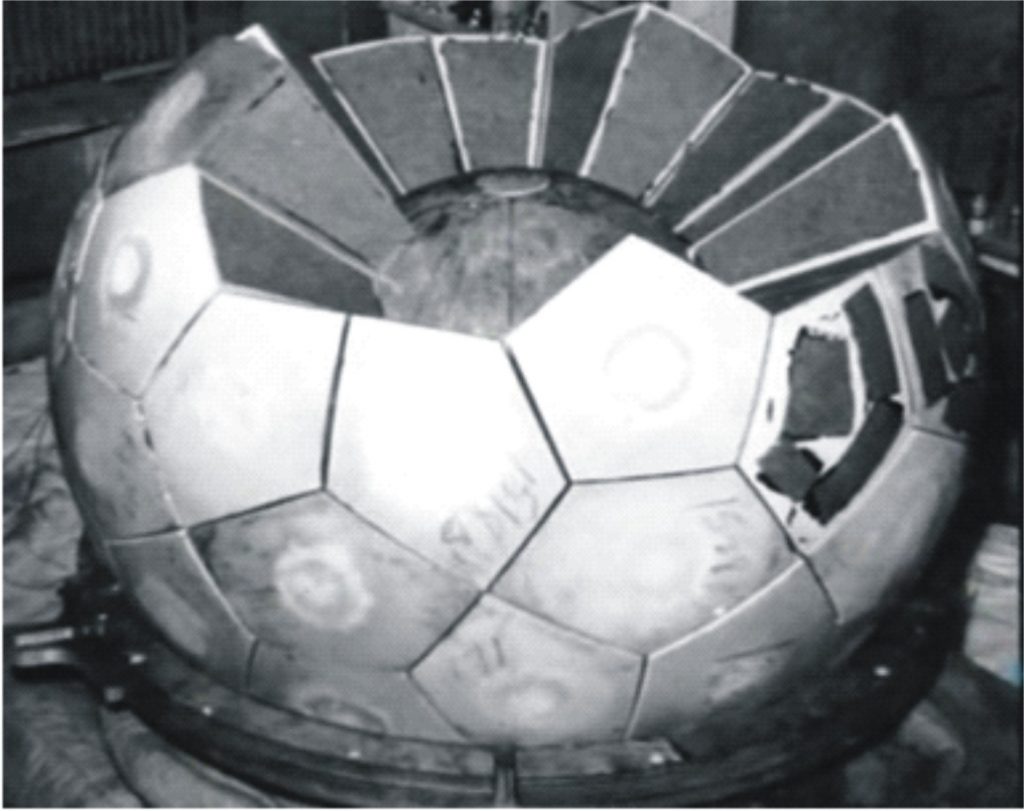
Kistiakowsky based his designs for the explosive lenses off of Bruno Rossi’s successful experiments with controlled symmetrical waves (Kunetka, p. 234). Standard rectangular blocks of explosive material were cut into the shape of a five- or six-sided pyramid with its tip cut off. In his interview, Kistiakowsky explained that “all of these lenses surrounded the tamper, and the tamper mainly served as a reflector for neutrons so that they go back.”
The tamper was a layer that surrounded the core of plutonium. Besides reflecting neutrons, Kistiakowsky added that the tamper helped “to smooth the shockwave that was produced by the detonation wave.” British physicist James Tuck, who was a member of the British Mission to Los Alamos, described the sphere of lenses around the core as resembling a soccer ball.
Two types of explosives were used in the lenses. The first type was Composition B (“Comp B”), a mixture of RDX and molten TNT. RDX is a type of melting powder, and when RDX is combined with TNT, the mixture is called a cyclonite (LASL Explosive Property Data, p. 11). According to Kistiakowsky, RDX was chosen because one of his “associate organic chemists, primarily Dr. [Werner] Bachmann of the University of Michigan, discovered the so-called Process B—Bachmann—of making RDX relatively economically.” As a high-velocity explosive, Composition B was placed on the outside of the lens.
The second type of explosive was Baratol. Needing an explosive of a very low velocity, Kistiakowsky noted that he “assigned the job to his friends at an explosives research laboratory in Pittsburgh, the so-called Bruceton Laboratory, of which I was the chief until I went to Los Alamos.” At the Pittsburgh laboratory, Dr. Duncan McDougall and an associate developed the Baratol explosive. With a low velocity of detonation, Baratol provided a changed fractured index of the interface, which would cause the explosive wave to bend and create the spherical implosion shockwave.
Trinity Test
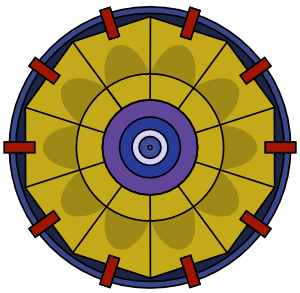
On July 16, 1945, the Gadget device was tested in Alamogordo, NM at Trinity Site. The test’s success provided evidence that each of these innovations functioned properly and effectively. The following excerpt from James Kunetka’s The General and the Genius: Groves and Oppenheimer – The Unlikely Partnership that Built the Atomic Bomb provides an inside look at what was happening inside the Gadget as the test began:
“As soon as the automated firing circuit closed at the command bunker, the electronic X-unit on the side of the bomb discharged, sending five thousand volts to thirty-two detonators, which in turn simultaneously ignited the outer row of fast-burning explosive lenses. The initial explosive wave was reformed by the slower-burning inserts of Baratol and became concave. The imploding wave ignited the inner layer of Comp B explosives and accelerated, slamming into the aluminum pusher and tamper, liquefying them, and ultimately compressing the Pu239 core and its initiator. At that instant, the beryllium and polonium combined to generate a flood of neutrons that took the core from subcritical to supercritical. Only eighty generations of neutrons hitting atoms and freeing other neutrons were needed to release an incompressible amount of energy. All this took place in a millionth of a second.”
Fat Man
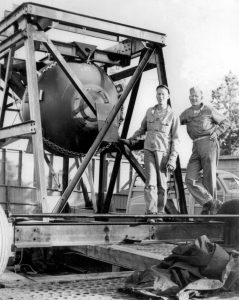
Prior to use in World War II, the Fat Man units underwent a number of tests. In his interview on the Voices of the Manhattan Project website, Walter Goodman described some of the tests performed on the Fat Man units. He said they “had to determine whether this new construction of a weapon was going to stay together when it went up to a very low temperature – it was a great deal of vibration – and then dropped from a plane. Would the thing fall apart? Would it stay together?”
Goodman recalled running “shake tests with dummy concrete lenses and then produced HE [high-explosive] lenses to see if they would work.” They also performed “cold tests” on Fat Man units. According to Goodman, “they ran the cold test first by dry ice and a coal box. Then they ran the cold test in the bomb bay of B-29s.” Finally, they dropped dummy or “pumpkin bombs” to determine the bombs’ trajectory.
The “pumpkin bomb” missions were used for testing and training purposes, meant to prepare the Groups for future atomic missions. These bombs were similar in size, weight, and drop characteristics to the “Fat Man” atomic bomb. So, these bombs were meant to be used for practice, but they were still later used to aim at targets throughout Japan.
The term “pumpkin bomb” applies to both the dummy concrete bombs used at Wendover, and the HE filled ones dropped over Japan at these targets. The dummy “pumpkin bombs” were used by the 393rd Squadron. When the 509th Composite Group arrived to Tinian, these bombs were not used as dummy bombs, but were used as destructive forces on targets in 51 combat missions.
On August 9, 1945, Fat Man was dropped on Nagasaki, Japan. Just like the Gadget device at Trinity, Fat Man was a plutonium-based implosion bomb. Fat Man featured a softball-sized, subcritical plutonium core surrounded by 5,300 pounds of high explosive lenses. Upon detonation, the lenses sent a spherical shockwave inward, crushing the core to the size of a tennis ball and into a supercritical state. The explosive force of the 10,800-pound Fat Man bomb was equivalent to 21 kilotons or 46,000,000 pounds of TNT.
Legacy of Electronics Innovations at Los Alamos
Since World War II, the electronics innovations at Los Alamos have been used in a variety of applications beyond weapons development. EBWs have been used in NASA rockets and the mining and quarry industry. Spark gap technology continues to be used for power switching devices in the medical field with lithotripters, as well as in high-speed photography with flash tubes. Recently, explosive lenses were used to create a simple plane waves generator.





